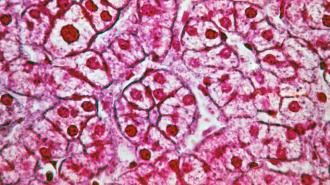A new obesity treatment triggered weight loss in mice, even as they continued to eat a diet high in fat, sugar, and cholesterol. While much more research is needed, it suggests that it may be possible for people to one day lose weight while still enjoying the foods they want.
The challenge: By 2020, nearly 1 billion people had body mass indexes (BMIs) in the obese range, and if current trends continue, more than 50% of the global population will be obese or overweight by 2035.
This means the majority of people on Earth will be at higher risk of serious health problems related to weight, including stroke, diabetes, hypertension, and some cancers.
While it is possible to lose weight and keep it off with diet and exercise, it’s not easy, so there’s an urgent need for new obesity treatments to mitigate this major health crisis.
“The treated mice completely lost their gained weight, and we did not see any untoward side effects.”
S. Thai Thayumanavan
What’s new? Researchers at the University of Massachusetts Amherst (UMass) have developed an obesity treatment that caused obese mice to shed their excess weight — even while eating a poor diet, high in fat, sugar, and cholesterol.
“The treated mice completely lost their gained weight, and we did not see any untoward side effects,” said senior author S. Thai Thayumanavan. “Considering 100 million Americans have obesity and related cardiometabolic disorders, we became pretty excited about this work.”
How it works: The new obesity treatment centered on axitirome, which is a type of drug known as a “thyromimetic.” These are synthetic versions of thyroid hormones, which play an important role in metabolism, and people taking them have been known to lose weight.
However, the drugs aren’t very potent, so high doses are needed when they’re delivered systemically, and those can cause intolerable side effects — in the 1990s, a clinical trial of axitirome for high cholesterol was discontinued due to the side effects.
To avoid rampant side effects while still delivering a dosage high enough to trigger weight loss, the UMass team packaged their axitirome in IntelliGels, a type of nanogel carrier they developed to deliver payloads to specific targets in the body.
The mice returned to a normal weight, even though they were still eating the same quantity of the same food.
After feeding mice the high-fat, high-sugar diet for 24 weeks to double their weight, the researchers began giving the obese rodents daily injections containing their axitirome-packed IntelliGels.
After five weeks of the shots, the mice were back at a normal weight, even though they were still eating the same quantity of the same food. The obesity treatment also lowered the rodents’ cholesterol levels and resolved their liver inflammation, without causing apparent side effects.
“We found that we are activating the reverse cholesterol transport pathway, which lowers cholesterol,” said Thayumanavan. “We believe that activation of fat oxidation and an increase in metabolic rate are causing the loss in weight, but more work needs to be done to prove that point.”
The cold water: The results of the mouse study are promising, but mice have quite different metabolism and physiology than humans. Daily injections are also not the most convenient obesity treatment, and it seems the med would need to be taken indefinitely if a person didn’t also adjust their diet, which, again, can be tough.
Obesity isn’t the only problem associated with eating a diet high in fat, sugar, and cholesterol, either, and it’s not clear whether such a treatment would negate some of the other issues, such as an increased risk of diabetes. There may be other drawbacks of a permanent boost in metabolic rate and fat oxidation, too, which will need to be studied.
The obesity treatment also lowered the rodents’ cholesterol levels and resolved their liver inflammation.
Looking ahead: Still, now that the researchers know their treatment works in mice, they can focus on confirming how it works and start laying the groundwork for clinical trials.
“There is a significant amount of development work to be conducted between mice and humans,” said Thayumanavan, “but we are hoping it will eventually become a drug.”
If it does, it will need to compete with a number of other promising obesity treatments, especially the recently approved semaglutide and other similar drugs, which cause people to feel less hungry to begin with.
We’d love to hear from you! If you have a comment about this article or if you have a tip for a future Freethink story, please email us at tips@freethink.com.
